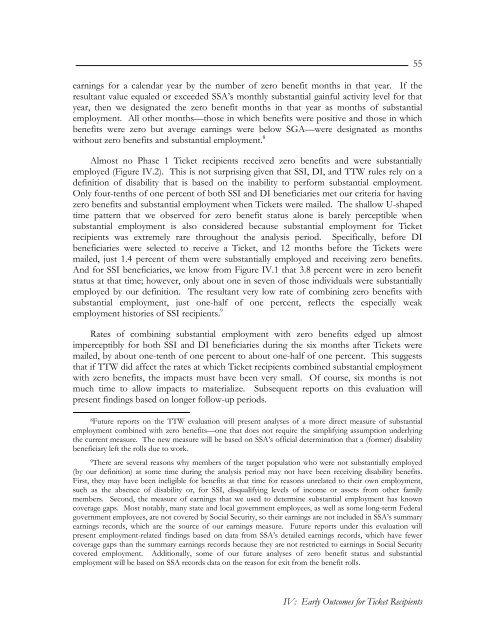Evaluation of the Ticket to Work Program, Implementation ...
Evaluation of the Ticket to Work Program, Implementation ...
Evaluation of the Ticket to Work Program, Implementation ...
Create successful ePaper yourself
Turn your PDF publications into a flip-book with our unique Google optimized e-Paper software.
earnings for a calendar year by <strong>the</strong> number <strong>of</strong> zero benefit months in that year. If <strong>the</strong>resultant value equaled or exceeded SSA’s monthly substantial gainful activity level for thatyear, <strong>the</strong>n we designated <strong>the</strong> zero benefit months in that year as months <strong>of</strong> substantialemployment. All o<strong>the</strong>r months—those in which benefits were positive and those in whichbenefits were zero but average earnings were below SGA—were designated as monthswithout zero benefits and substantial employment. 8Almost no Phase 1 <strong>Ticket</strong> recipients received zero benefits and were substantiallyemployed (Figure IV.2). This is not surprising given that SSI, DI, and TTW rules rely on adefinition <strong>of</strong> disability that is based on <strong>the</strong> inability <strong>to</strong> perform substantial employment.Only four-tenths <strong>of</strong> one percent <strong>of</strong> both SSI and DI beneficiaries met our criteria for havingzero benefits and substantial employment when <strong>Ticket</strong>s were mailed. The shallow U-shapedtime pattern that we observed for zero benefit status alone is barely perceptible whensubstantial employment is also considered because substantial employment for <strong>Ticket</strong>recipients was extremely rare throughout <strong>the</strong> analysis period. Specifically, before DIbeneficiaries were selected <strong>to</strong> receive a <strong>Ticket</strong>, and 12 months before <strong>the</strong> <strong>Ticket</strong>s weremailed, just 1.4 percent <strong>of</strong> <strong>the</strong>m were substantially employed and receiving zero benefits.And for SSI beneficiaries, we know from Figure IV.1 that 3.8 percent were in zero benefitstatus at that time; however, only about one in seven <strong>of</strong> those individuals were substantiallyemployed by our definition. The resultant very low rate <strong>of</strong> combining zero benefits withsubstantial employment, just one-half <strong>of</strong> one percent, reflects <strong>the</strong> especially weakemployment his<strong>to</strong>ries <strong>of</strong> SSI recipients. 9Rates <strong>of</strong> combining substantial employment with zero benefits edged up almostimperceptibly for both SSI and DI beneficiaries during <strong>the</strong> six months after <strong>Ticket</strong>s weremailed, by about one-tenth <strong>of</strong> one percent <strong>to</strong> about one-half <strong>of</strong> one percent. This suggeststhat if TTW did affect <strong>the</strong> rates at which <strong>Ticket</strong> recipients combined substantial employmentwith zero benefits, <strong>the</strong> impacts must have been very small. Of course, six months is notmuch time <strong>to</strong> allow impacts <strong>to</strong> materialize. Subsequent reports on this evaluation willpresent findings based on longer follow-up periods.8 Future reports on <strong>the</strong> TTW evaluation will present analyses <strong>of</strong> a more direct measure <strong>of</strong> substantialemployment combined with zero benefits—one that does not require <strong>the</strong> simplifying assumption underlying<strong>the</strong> current measure. The new measure will be based on SSA’s <strong>of</strong>ficial determination that a (former) disabilitybeneficiary left <strong>the</strong> rolls due <strong>to</strong> work.9 There are several reasons why members <strong>of</strong> <strong>the</strong> target population who were not substantially employed(by our definition) at some time during <strong>the</strong> analysis period may not have been receiving disability benefits.First, <strong>the</strong>y may have been ineligible for benefits at that time for reasons unrelated <strong>to</strong> <strong>the</strong>ir own employment,such as <strong>the</strong> absence <strong>of</strong> disability or, for SSI, disqualifying levels <strong>of</strong> income or assets from o<strong>the</strong>r familymembers. Second, <strong>the</strong> measure <strong>of</strong> earnings that we used <strong>to</strong> determine substantial employment has knowncoverage gaps. Most notably, many state and local government employees, as well as some long-term Federalgovernment employees, are not covered by Social Security, so <strong>the</strong>ir earnings are not included in SSA’s summaryearnings records, which are <strong>the</strong> source <strong>of</strong> our earnings measure. Future reports under this evaluation willpresent employment-related findings based on data from SSA’s detailed earnings records, which have fewercoverage gaps than <strong>the</strong> summary earnings records because <strong>the</strong>y are not restricted <strong>to</strong> earnings in Social Securitycovered employment. Additionally, some <strong>of</strong> our future analyses <strong>of</strong> zero benefit status and substantialemployment will be based on SSA records data on <strong>the</strong> reason for exit from <strong>the</strong> benefit rolls.55IV: Early Outcomes for <strong>Ticket</strong> Recipients
















